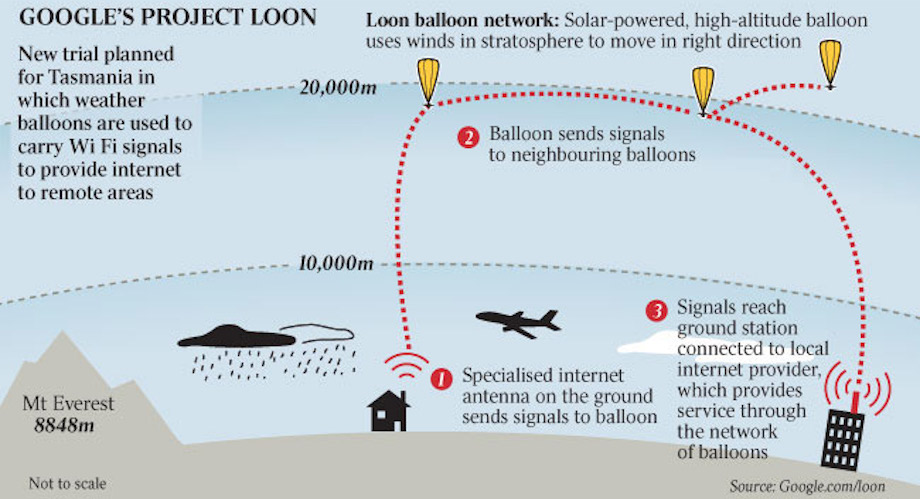Project Loon
 What is Project Loon?
What is Project Loon?
Many of us think of the internet as a global community. But two-thirds of the world’s population does not yet have internet access. Project Loon is a network of balloons traveling on the edge of space, designed to connect people in rural and remote areas, help fill coverage gaps, and bring people back online after disasters.
How does Project Loon work?
Project Loon balloons float in the stratosphere, twice as high as airplanes and the weather. In the stratosphere, there are many layers of wind, and each layer of wind varies in direction and speed. Loon balloons go where they’re needed by rising or descending into a layer of wind blowing in the desired direction of travel. By partnering with Telecommunications companies to share cellular spectrum we’ve enabled people to connect to the balloon network directly from their phones and other LTE-enabled devices. The signal is then passed across the balloon network and back down to the global internet on Earth.
The project uses high-altitude balloons placed in the stratosphere at an altitude of about 18 km (11 mi) to create an aerial wireless network with up to 4G-LTE speeds. It was named Project Loon, since even Google itself found the idea of providing Internet access to the remaining 5 billion population unprecedented and "crazy."
 The balloons are maneuvered by adjusting their altitude in the stratosphere to float to a wind layer after identifying the wind layer with the desired speed and direction using wind data from the National Oceanic and Atmospheric Administration (NOAA). Users of the service connect to the balloon network using a special Internet antenna attached to their building. The signal travels through the balloon network from balloon to balloon, then to a ground-based station connected to an Internet service provider (ISP), then onto the global Internet. The system aims to bring Internet access to remote and rural areas poorly served by existing provisions, and to improve communication during natural disasters to affected regions. Key people involved in the project include Rich DeVaul, chief technical architect, who is also an expert on wearable technology; Mike Cassidy, a project leader; and Cyrus Behroozi, a networking and telecommunication lead.
The balloons are maneuvered by adjusting their altitude in the stratosphere to float to a wind layer after identifying the wind layer with the desired speed and direction using wind data from the National Oceanic and Atmospheric Administration (NOAA). Users of the service connect to the balloon network using a special Internet antenna attached to their building. The signal travels through the balloon network from balloon to balloon, then to a ground-based station connected to an Internet service provider (ISP), then onto the global Internet. The system aims to bring Internet access to remote and rural areas poorly served by existing provisions, and to improve communication during natural disasters to affected regions. Key people involved in the project include Rich DeVaul, chief technical architect, who is also an expert on wearable technology; Mike Cassidy, a project leader; and Cyrus Behroozi, a networking and telecommunication lead.
The balloons use patch antennas - which are directional antennas - to transmit signals to ground stations or LTE users. Some smartphones with Google SIM cards can use Google Internet services. The whole infrastructure is based on LTE; the eNodeB component (the equivalent of the "base station" that talks directly to handsets) is carried in the balloon.
Technology
Project Loon is Google's pursuit to deploy a high-altitude balloon network operating in the stratosphere, at altitudes between 18 km and 25 km. Google asserts that this particular layer of the stratosphere is advantageous because of its relatively low wind speeds (e.g., wind speeds between 5 and 20 mph / 10 to 30 kmph) and minimal turbulence. Moreover, Google claims that it can model, with reasonable accuracy, the seasonal, longitudinal, and latitudinal variations in wind speeds within the 18–25 km stratospheric layer.
Given a reasonably accurate model of wind speeds within the 18–25 km band, Google claims that it can control the latitudinal and longitudinal position of high-altitude balloons by adjusting only the balloon's altitude. By adjusting the volume and density of the gas (e.g., helium, hydrogen, or another lighter-than-air compound) in the balloon, the balloon's variable buoyancy system is able to control the balloon's altitude. Google has additionally indicated that balloons may be constructed from various materials (e.g., metalized Mylar or BoPET) or a highly flexible latex or rubber material (e.g., chloroprene).
On 16 June 2013, Google began a pilot experiment in New Zealand where about 30 balloons were launched in coordination with the Civil Aviation Authority from the Tekapo area in the South Island. About 50 local users in and around Christchurch and the Canterbury Region tested connections to the aerial network using special antennas. Initially, the balloons communicated using unlicensed 2.4 and 5.8 GHz ISM bands, and Google claims that the setup allows it to deliver "speeds comparable to 3G" to users, but they then switched to LTE with cellular spectrum by cooperating with local telecommunication operators. It is unclear how technologies that rely on short communications times (low latency pings), such as VoIP, might need to be modified to work in an environment similar to mobile phones where the signal may have to relay through multiple balloons before reaching the wider Internet.
The technology designed in the project could allow countries to avoid using expensive fiber cable that would have to be installed underground to allow users to connect to the Internet. Google feels this will greatly increase Internet usage in developing countries in regions such as Africa and Southeast Asia that can't afford to lay underground fiber cable.
Equipment
The balloon envelopes used in the project are made by Raven Aerostar, and are composed of polyethylene plastic about 0.076 mm (0.0030 in) thick. The balloons are super pressure balloons filled with helium, standing 15 m (49 ft) across and 12 m (39 ft) tall when fully inflated. They carry a custom air pump system dubbed the "Croce" that pumps in or releases air to ballast the balloon and control its elevation. A small box weighing 10 kg (22 lb) containing each balloon's electronic equipment hangs underneath the inflated envelope. This box contains circuit boards that control the system, radio antennas and a Ubiquiti Networks 'Rocket M2' to communicate with other balloons and with Internet antennas on the ground, and batteries to store solar power so the balloons can operate during the night. Each balloon’s electronics are powered by an array of solar panels that sit between the envelope and the hardware. In full sun, the panels produce 100 watts of power, which is sufficient to keep the unit running while also charging a battery for use at night. A parachute attached to the top of the envelope allows for a controlled descent and landing when a balloon is ready to be taken out of service. In the case of an unexpected failure, the parachute deploys automatically. When taken out of service, the balloon is guided to an easily reached location, and the helium is vented into the atmosphere. The balloons typically have a maximum life of about 100 days, although Google claims that its tweaked design can enable them to stay aloft for closer to 200 days.
A world of benefits
Project Loon is clearly an asset to Google. However, it is also a convenience to the rest of the world. One of the most obvious avails of the project is the Availability of Information. Assuming all the mechanisms of the project are functioning as planned, every single person who has access to some device that has wifi access would be able to search for almost any form of media online. Farmers in remote corners of third world countries would be able to research and analyze multiple techniques that could increase their yield, a father would be able to stay in touch with his daughter no matter which township either one of them lived in, villagers across an country would be able to transparently examine the country’s political scenario and vote appropriately.
The second benefit is naturally Education. With millions of uneducated children all across the world, this program might be able to successfully provide schooling through online classes on topics ranging anywhere from disaster management to literary analysis. Even without any additional content, these new users would at the very least have access to existing online resources including W3School, CodeAcademy and many others.
Health and Medicine is another area that will be affected by Loon. With globally available data on disease outbreaks and medical breakthrough, the entire population will be able to adjust to epidemics or adopt new drugs or medications.
Loon’s Use of Renewable Energy will greatly influence and inspire future projects as well. Creating an interplay between solar energy to keep the balloon functional while using wind energy to define its motor controls will help reduce the burden on coal, petroleum and other non-renewable energy sources.
Finally, Collaboration between people across the globe will become much easier with the constant connectivity to the each other through the internet, allowing newer more complicated projects to arise. For example, NGO’s in Africa could clearly demonstrate to their investors from Canada precisely how they are implementing their communal goals.
Concerns
The main problem with launching any hardware project is the certainty of eventual hardware failure. In most cases, the hardware is usually accessible and can be fixed. However, for airplanes, rockets, satellites, and now Loon balloons, hardware failure is a huge problem as they cannot be reached. If a Loon balloon fails, it can either remain up in the air floating, making it difficult to bring down or it might go down in unwanted areas. Both of these scenarios are a huge concern to the stability as well as the safety of people whose lives might be affected by unwanted balloon landings.
Another concern over this project is internet privacy since it gives Google more power over a wider range of consumer behavior. This information can become a security issue if it is shared with Government agencies like the NSA.
Finally, the last apprehension about this project is its monopolistic tendency. In the future, assuming no other company manages to initiate such a wide scale project, Google can utilize its monopoly over the internet by either charging money for Project Loon usage or even converge on favoritism by marketing Chromebooks and Android phones but limiting the accessibility of other company’s laptops and devices on the Loon web service.